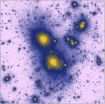(Press-News.org) LAWRENCE — Astrophysicists believe that about 80 percent of the substance of our universe is made up of mysterious "dark matter" that can't be perceived by human senses or scientific instruments.
"Dark matter has not yet been detected in a lab. We infer about it from astronomical observations," said Mikhail Medvedev, professor of physics and astronomy at the University of Kansas, who has just published breakthrough research on dark matter that merited the cover of Physical Review Letters, the world's most prestigious journal of physics research.
Medvedev proposes a novel model of dark matter, dubbed "flavor-mixed multicomponent dark matter."
"Dark matter is some unknown matter, most likely a new elementary particle or particles beyond the Standard Model," Medvedev said. "It has never been observed directly, but it reveals itself via gravity it produces in the universe. There are numerous experiments around the world aimed at finding it directly."
Medvedev's theory rests on the behavior of elementary particles that have been observed or hypothesized. According to today's prevalent Standard Model theory of particle physics, elementary particles — categorized as varieties of quarks, leptons and gauge bosons — are the building blocks of an atom. The properties, or "flavors," of quarks and leptons are prone to change back and forth, because they can combine with each other in a phenomenon called flavor-mixing.
"In everyday life we've become used to the fact that each and every particle or an atom has a certain mass," Medvedev said. "A flavor-mixed particle is weird — it has several masses simultaneously — and this leads to fascinating and unusual effects."
Medvedev compared flavor-mixing to white light that contains several colors and can generate a rainbow.
"If white was a particular flavor, then red, green and blue would be different masses — masses one, two and three — that mix up together to create white," he said. "By changing proportions of red, green and blue in the mix, one can make different colors, or flavors, other than white."
Medvedev said that dark matter candidates are also theorized to be flavor-mixed — such as neutralinos, axions and sterile neutrinos.
"These are, in fact, the most preferred candidates people speak about all the time," Medvedev said.
"Previously we discovered that flavor-mixed particles can 'quantum evaporate' from a gravitational well if they are 'shaken' — meaning they collide with another particle," he said. "That's a remarkable result, as if a spacecraft made of flavor-mixed matter and hauled along a bumpy road puts itself into space without a rocket or any other means or effort by us."
Medvedev included the physics process of quantum evaporation in a "cosmological numerical code" and performed simulations using supercomputers.
"Each simulation utilized over a 1,000 cores and ran for a week or so," he said. "This yearlong project consumed about 2 million computer hours in total, which is equal to 230 years."
Medvedev said that dark matter may interact with normal matter extremely weakly, which is why it hasn't been revealed already in numerous ongoing direct detection experiments around the world. So physicists have devised a working model of completely collisionless (noninteracting), cold (that is, having very low thermal velocities) dark matter with a cosmological constant (the perplexing energy density found in the void of outer space), which they term the "Lambda-CDM model."
But the model has hasn't always agreed with observational data, until Medvedev's paper solved the theory's long-standing and troublesome puzzles.
"Our results demonstrated that the flavor-mixed, two-component dark matter model resolved all the most pressing Lambda-CDM problems simultaneously," said the KU researcher.
Medvedev performed the simulations using XSEDE high-performance computation facilities, primarily Trestles at the San Diego Supercomputer Center and Ranger at the Texas Advanced Computing Center.
INFORMATION: END
Researcher advances a new model for a cosmological enigma -- dark matter
2014-09-04
ELSE PRESS RELEASES FROM THIS DATE:
Atomically thin material opens door for integrated nanophotonic circuits
2014-09-04
A new combination of materials can efficiently guide electricity and light along the same tiny wire, a finding that could be a step towards building computer chips capable of transporting digital information at the speed of light.
Reporting today in The Optical Society's (OSA) high-impact journal Optica, optical and material scientists at the University of Rochester and Swiss Federal Institute of Technology in Zurich describe a basic model circuit consisting of a silver nanowire and a single-layer flake of molybendum disulfide (MoS2).
Using a laser to excite electromagnetic ...
Trinity geologists re-write Earth's evolutionary history books
2014-09-04
Geologists from Trinity College Dublin have rewritten the evolutionary history books by finding that oxygen-producing life forms were present on Earth some 3 billion years ago – a full 60 million years earlier than previously thought. These life forms were responsible for adding oxygen (O2) to our atmosphere, which laid the foundations for more complex life to evolve and proliferate.
Working with Professors Joydip Mukhopadhyay and Gautam Ghosh and other colleagues from the Presidency University in Kolkata, India, the geologists found evidence for chemical weathering of ...
Study: Oxidized LDL might actually be 'good guy'
2014-09-04
LEXINGTON, Ky (Sept. 4, 2014) -- A team of investigators at the University of Kentucky has made a thought-provoking discovery about a type of cholesterol previously believed to be a "bad guy" in the development of heart disease and other conditions.
Jason Meyer, a University of Kentucky MD-PhD candidate, worked with Deneys van der Westhuyzen, Ph.D., a Professor in the Departments of Internal Medicine and Molecular and Cellular Biochemistry, to study the role oxidized LDL plays in the development of plaque inside artery walls.
According to Meyer, the medical research ...
Research shows declining levels of acidity in Sierra Nevada lakes
2014-09-04
RIVERSIDE, Calif. — California's water supply depends on a clean snow pack and healthy mountain lakes. The lakes receive a large amount of runoff in the spring from the melting snowpack. If the snowpack is polluted, the lakes will be polluted.
James O. Sickman, an environmental scientist at the University of California, Riverside, has conducted research on lakes in the Sierra Nevada—the most sensitive lakes in the U.S. to acid rain, according to the Environmental Protection Agency—and described human impacts on them during the 20th century. The research was done by ...
New research offers help for spinal cord patients
2014-09-04
Many patients suffer from severe spinal cord injuries after being involved in traffic accidents or accidents at work. An injury to the spinal cord is a catastrophe for the individual, and often results in complete or partial paralysis of the person's arms and legs. Despite the paralysis, several patients experience problems with involuntary muscle contractions or spasms which impair the patient's quality of life.
The movements are due to the neurotransmitter serotonin, which normally plays a crucial role in relation to our voluntary control of movements by reinforcing ...
Mantle plumes crack continents
2014-09-04
In some parts of the Earth, material rises upwards like a column from the boundary layer of the Earth's core and the lower mantel to just below the Earth's crust hundreds of kilometres above. Halted by the resistance of the hard crust and lithospheric mantle, the flow of material becomes wider, taking on a mushroom-like shape. Specialists call these magma columns "mantle plumes" or simply "plumes".
Are mantel plumes responsible for the African rift system?
Geologists believe that plumes are not just responsible for creating volcanoes outside of tectonically active areas ...
Implact of dexamethasone on intelligence and hearing in preterm infants
2014-09-04
Glucocorticoids are speculated to have a long-term impact on the development of the nervous system and increase the incidence of cerebral palsy in preterm infants. The existing studies concerning the role of dexamethasone in preterm infants are insufficiently reliable owing to short follow-up periods and small sample sizes in clinical studies, or the absence of randomized controlled trials. Ruolin Zhang and co-workers from the Second Xiangya Hospital, Central South University in China conducted a meta-analysis of 10 relevant randomized controlled trials. They found that ...
Apolipoprotein E and apolipoprotein CI are involved in cognitive impairment progression in Chinese late-onset Alzheimer's disease
2014-09-04
Current evidence shows that apolipoprotein E (APOE), apolipoprotein CI (APOC1) and low density lipoprotein receptor-related protein (LRP) variations are related to late-onset Alzheimer's disease. However, it remains unclear if genetic polymorphisms in these genes are associated with cognitive decline in late-onset Alzheimer's disease patients. According to a recent study reported in the Neural Regeneration Research, APOE ε4 plays an important role in augmenting cognitive decline, and APOC1 H2 may act synergistically with APOE ε4 in increasing the risk of cognitive ...
Cystic fibrosis: Additional immune dysfunction discovered
2014-09-04
Cystic fibrosis (mucoviscidosis) is due to a mutation of an ion channel which leads to highly viscous mucus and to dysfunction of the lung and the gastrointestinal organs. Since these patients frequently suffer from chronic infections, Dr. Thomas Hofer and Professor Dr. Loems Ziegler-Heitbrock from the Comprehensive Pneumology Center (CPC) at Helmholtz Zentrum München - together with colleagues at the Klinikum der Universität München and the University of Leicester, UK - investigated, whether these patients might have an additional immune defect. The scientists found ...
Finding new approaches for therapeutics against Ebola virus
2014-09-04
Researchers from the University of Liverpool in collaboration with Public Health England have been investigating new ways to identify drugs that could be used to treat Ebola virus infection.
Their approach has been to study what proteins inside a cell are critical for the functions of Ebola virus and are hijacked by the virus to help with infection. One of the proteins they have targeted is known as VP24. This protein disrupts signalling in infected human cells and disrupts the body's immune system and the fight against the virus.
Once the team identified these cellular ...




